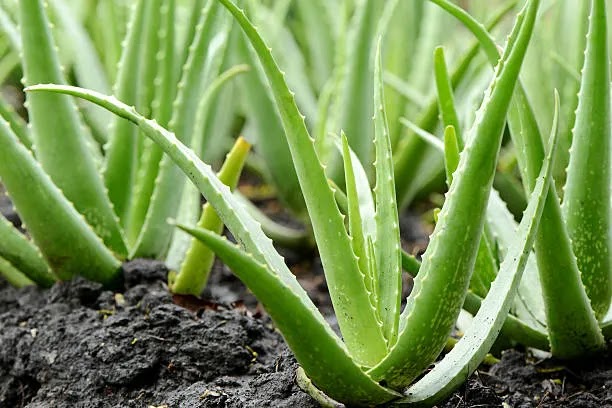Aloe vera is a well-known
medicinal plant that humans have utilized for thousands of years.
Aloe vera, also known as Aloe barbadensis, is a thick,
short-stemmed plant with leaves that store water. It is most recognized for
curing skin injuries, but it also has several other uses that may benefit one's
health.
Aloe vera has eight potential health benefits, according to this
article. It also explains some of the dangers that come with using it.
1. It contains healthful plant compounds
Aloe vera is widely used in the cosmetic, pharmaceutical, and food
industries, and the plant has a global market value of $13 billion.
Aloe vera is differentiated by its thick, pointed, and fleshy
green leaves, which can reach a length of 12–19 inches (30–50 centimeters).
The leaves are thick because they contain a slimy tissue that
holds water in each leaf. This water-filled tissue is the "gel" that
people associate with aloe vera products.
Most of the plant's critical bioactive compounds, such as
vitamins, minerals, amino acids, and antioxidants, are found in the gel.
2. It has antioxidant and antibacterial properties
Antioxidants are essential for good health. Aloe vera gel includes
powerful antioxidants known as polyphenols, a broad group of compounds.
These polyphenols, along with several other compounds found in
aloe vera, aid in preventing the growth of bacteria that can cause illnesses in
humans.
The antibacterial, antiviral, and antiseptic effects of aloe vera
are well-known. This is one of the reasons why it may aid in the healing of
wounds and the treatment of skin conditions.
3. It accelerates wound healing
Aloe vera is most commonly used as a topical medication, which is
applied to the skin rather than consumed. Indeed, it has a long history of
being used to cure wounds and burns, including sunburn.
As early as 1810–1820, the United States Pharmacopeia lists aloe
vera products as a skin protectant.
According to studies, it appears to be an effective topical
treatment for first and second-degree burns.
An analysis of experimental research indicated that aloe vera
could reduce the amount of time it took for burns to recover by about nine days
instead of standard treatment. It also helps to avoid infections, redness, and
irritation.
Although there is no solid evidence that aloe vera can help treat
other types of wounds, the research is promising.
4. It reduces dental plaque
Tooth decay and gum disorders are relatively prevalent health
issues. Reduced plaque, or bacterial biofilms, on the teeth is one of the most
excellent strategies to prevent these problems.
Researchers compared 100 percent pure aloe vera juice to chlorhexidine's
standard mouthwash ingredient in a mouth rinse study of 300 healthy
participants.
After four days of treatment, the aloe vera mouth rinse appeared
to be just as effective as chlorhexidine in decreasing dental plaque.
Over a 15- to 30-day timeframe, another study discovered similar
effects of aloe vera mouth rinse.
The plaque-producing bacterium Streptococcus mutants and the yeast
Candida albicans are killed by aloe vera in the mouth.
5. It helps treat canker sores
Mouth ulcers, often known as canker sores, affect many people at
some point in their life. These appear beneath the top lip, inside the mouth,
and stay about a week.
Aloe vera treatment has been found in studies to speed up the
healing of mouth ulcers.
Applying an aloe vera patch to the location of recurrent mouth
ulcers, for example, was beneficial in reducing the size of the ulcers in a
7-day study of 180 persons with recurrent mouth ulcers.
It did not, however, outperform the standard ulcer treatment,
corticosteroids.
According to another study, Aloe vera gel not only accelerated the
healing of mouth ulcers but also reduced the pain associated with them.
6. It reduces constipation
Constipation may also be helped by aloe vera.
The latex, not the gel, is the source of the benefits this time.
The latex is a sticky yellow residue found immediately beneath the leaf's skin.
Aloin, also known as barbaloin, is the main compound responsible
for this effect. It has long been known to have laxative effects.
On the other hand, people have expressed worries about the safety
of repeated use. As a result, aloe latex has been available as an
over-the-counter treatment in the United States since 2002.
Contrary to widespread assumption, other digestive problems, such
as irritable bowel syndrome or inflammatory bowel disease, do not appear to be
helped by aloe vera.
7. It may improve skin and prevent wrinkles
There is some preliminary evidence that topical aloe vera gel can
help to slow down skin aging.
Taking oral aloe vera gel for 90 days enhanced collagen production
and improved skin elasticity in 30 females over the age of 45, according to a
2009 study.
Aloe vera may also help the skin retain moisture and enhance skin
integrity, beneficial for people with dry skin.
8. It lowers blood sugar levels
Aloe vera is sometimes used as a diabetes treatment. This is
because it can increase insulin sensitivity and blood sugar control.
According to an analysis of eight research because of its effects
on glycemic control, aloe vera may be beneficial for persons with prediabetes
or type 2 diabetes.
However, because the quality of the existing research isn't
excellent, scientists don't recommend using aloe vera for this reason right
now.
Risks
Aloe vera is a natural medicine that has few side effects.
Topical usage, according to the National Center for Complementary and Integrative Health (NCCIH), is probably safe.
However, the laxative effects of aloe vera may produce stomach
pains or diarrhea when taken orally. In some cases, long-term aloe vera supplement
consumption has also been linked to liver damage.
According to the NCCIH, nondecolorized whole leaf aloe vera extract appears to be linked to cancer risk in rats.









